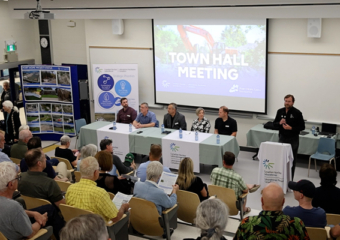 One consistent thing in Southern Ontario is the weather. It is usually the go-to topic of conversation, ranging from “how hot it is today”, to “the weather report is calling for some rain” or “a snow storm is on its way”. These days the topic for everyone is how hot it has been. With temperatures reaching in the mid-40s (degrees Celsius) with humidex, the heat has been especially top-of-mind for PHAI contractors who primarily work outside.
One consistent thing in Southern Ontario is the weather. It is usually the go-to topic of conversation, ranging from “how hot it is today”, to “the weather report is calling for some rain” or “a snow storm is on its way”. These days the topic for everyone is how hot it has been. With temperatures reaching in the mid-40s (degrees Celsius) with humidex, the heat has been especially top-of-mind for PHAI contractors who primarily work outside.
Though not strangers to working in extreme temperatures, each season PHAI workers are consistently reminded about safe practices. If it’s too cold, there’s the risk of frost bite or hypothermia and if it’s too hot, workers can suffer from heat stress.
“There are two things that every worker should be aware of at this time – acclimatization and hydration”, says Mark Dziarnowski, Site Safety Oversight Officer with Canadian Nuclear Laboratories (CNL). A veteran in the field of safety, Dziarnowski says that it is important for workers to ease into the activity – especially if it is heavy work. “And don’t forget to drink lots of water!”
“Working outside doing very physical activities like digging in your garden or building a deck is considered heavy work. When you have to also wear personal protective equipment to do the work, like contractors working on the Port Hope Harbour do while drilling and grouting, or when they need personal floatation devices, it can get very hard.” Mark suggests taking frequent breaks and not pushing yourself too hard.
In addition, workers are required to keep hydrated by taking water breaks, resting and using the cooling areas provided.
“At the harbour, there are portable shelters constructed on the barges and a boat that delivers water to workers, bearing in mind radiation zones where eating and drinking is prohibited,” adds Dziarnowski. All PHAI sites have built structures in work areas to beat the heat.
Each PHAI contractor is required to have a heat stress monitoring plan in place that identifies a work/rest regime to be followed. Site Health and Safety Officers monitor the status of the workers and ensure that they are being safe.
Contractors are using devices that give the WBGT – Wet Bulb Globe Temperature – considered the gold standard to determine not only the temperature but the effect of the temperature, including humidity, wind speed, and sunlight on humans and how much activity and for what duration each worker should be performing activities.
“As part of my oversight, I assess these plans to ensure they are realistic and adequate – that they don’t just look good on paper,” Dziarnowski added.
With the Canadian weather a mainstay, hot days are expected. So whether working on projects as large as the PHAI environmental cleanup or just doing some gardening, make sure you acclimatize and hydrate.
Rest and Drink!



